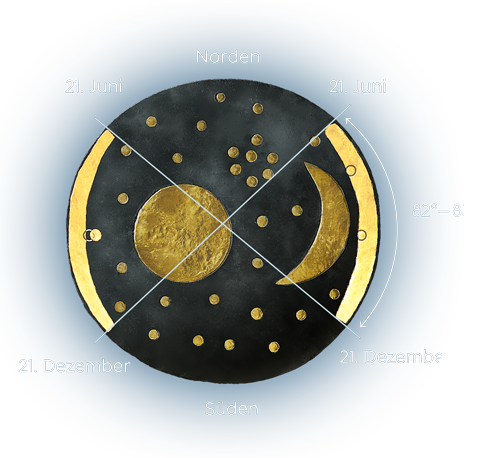Nebra Sky Disc
Today’s appearance of the Sky Disc is the result of multiple redesigns. The traces of manufacture and use, the materials employed, and the arrangement of the pictorial elements reveal a clear biography. Five phases can be distinguished.
The Leap Rule
Initially, the crescent and the circle stood out from what was then probably a black background of the Sky Disc. In them we recognise the crescent moon and the full moon or the sun. 32 stars completed the night sky.
Eye-catching is the cluster of seven stars between the two large celestial bodies. The star cluster depicts the Pleiades. They are mentioned as calendar stars in various cultures. On the Sky Disc, they are part of an image of the sky which can be observed every three years in spring: It is then that a crescent moon of the same thickness as shown on the Sky Disc, is near the Pleiades. If this was the case, a leap month had to be inserted in order to harmonise again the shorter lunar year with the solar year.
The upper star differs from the other stars due to its distinctive inlay ridge. Probably it was the first star which was mounted on the Sky Disc. It seems the artisan was not as practised with this star as with the subsequent gold appliqués. We notice the same ridge at the offset star near the left horizon arc, which in the second phase was possibly inserted by a different craftsperson.
The Horizon Arcs
In the next phase, two gold arcs were attached to the rim of the Sky Disc. They illustrate the rising and setting points of the sun throughout the course of the year, with the termini of the arcs indicating the precise rising and setting points at the summer and winter solstice.
At 82°, the angles correspond to the annual passage of the sun along the horizon in the latitudes of Middle Germany.

Beneath the still preserved arc the reliefs of two further stars are clearly visible. Both stars were covered by the horizon arc and removed before it was attached.
The left horizon arc is missing today. However, you can still see the inlay groove into which the gold sheet had been fitted.
One star had been relocated before the left horizon arc was attached. Its original outline is still clearly to be seen. When the star was moved, a small piece of gold was torn off which stuck in the inlay groove of the horizon arc.
The Sun Ship
The grooved arc near the lower edge of the Sky Disc differs significantly from the other gold ornaments. With regard to its shape and decoration, we can interpret it as a ship, as a celestial barque which – probably propelled by oars – travels along the horizon. It can be clearly recognised that the feathering of the barque avoids the nearby star. We know the symbol of the solar barge from a complex ancient Egyptian myth that explains the daily course of the sun and its rising and setting.
The Perforation
In the next phase the Sky Disc was perforated. The 39 holes are spaced at regular intervals along the rim of the Sky Disc. Presumably the disc was once attached to a support made of organic material. The perforation disregarded the gold ornaments.
The Deposition
The Sky Disc was deposited with other selected bronzes 3,600 years ago. There is every indication that the left horizon arc was no longer present prior to the deposition and was probably deliberately removed.
The Damage
The damage caused by the fire-fighter’s pickaxe with which the looters violently tore the Sky Disc out of the earth in 1999 is still visible today.
The notch on the edge of the full moon or the sun is further evidence of this damage. In addition, part of the gold ornament was so badly damaged by the axe that it had to be replaced by the conservators.
The forging marks are clearly visible on the back. They were created by cold forging the cast bronze blank. Furthermore, the outlines of individual elements on the front can be recognised – such as the celestial barque and the Pleiades.
Particularly noticeable is a five centimetre long groove on the back of the disc. It can be assumed that the bronze was tested here in order to select the right tool for working the Sky Disc. This had to be harder than the Sky Disc, which is made of a rather soft bronze alloy.
The Sky Disc can now be moved around freely and the individual chapters can be selected again in any order.
Imprint
Concept:
Robert Noack, Doris Wollenberg, Anja Stadelbacher
Production:
Lukas Fischer (3D Construct)
In cooperation with web developer:
Maximilian Berger
3D-Scan:
Thomas Bauer (ReplicArt Corpus Construction)
On behalf of:

© State Office for Heritage Management and Archaeology Saxony-Anhalt -State
Museum of Prehistory- Halle (Saale)